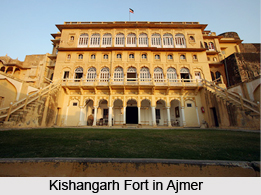 The picturesque yet the diminutive town of Kishangarh is located 27 kilometers away from Ajmer city. It is one of the popular tourist destinations around Ajmer city. Once upon a time it was the capital city of the princely state of the Rathores. Apart from being historically significant it was also well known for its craftsmanship. The famous Bani Thani style of miniature painting emerged from here. The pioneer of this form of art was Nihal Chand. He was the painter in court of Raja Sawant Singh.
The picturesque yet the diminutive town of Kishangarh is located 27 kilometers away from Ajmer city. It is one of the popular tourist destinations around Ajmer city. Once upon a time it was the capital city of the princely state of the Rathores. Apart from being historically significant it was also well known for its craftsmanship. The famous Bani Thani style of miniature painting emerged from here. The pioneer of this form of art was Nihal Chand. He was the painter in court of Raja Sawant Singh.
Apart form the local attractions within the town there are places of interest that are situated outside the town limits as well. While the tourists are on a trip to Kishangarh it is advisable that they check out the neighboring tourist destinations as well. Here the tourists will come across a fort that belongs to the Roopangarh region. Local transportations from Ajmer city are easily available for going on these excursion tours. The travelers can also avail the guided tours that will enable them to comprehend the historical nitty gritties better.



















